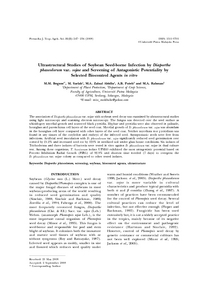Citation
Begum, Most Mahbuba and Meon, Sariah and Mior Ahmad, Zainal Abidin and Puteh, Adam and Rahman, Md. Aminur
(2008)
Ultrastructural studies of soybean seed-borne infection by Diaporthe phaseolorum var. sojae and screening of antagonistic potentiality by selected biocontrol agents in vitro.
Pertanika Journal of Tropical Agricultural Science, 31 (2).
pp. 247-256.
ISSN 1511-3701; ESSN: 2231-8542
Abstract
The association of Diaporthe phaseolorum var. sojae with soybean seed decay was examined by ultrastructural studies using light microscopy and scanning electron microscopy. The fungus was detected over the seed surface as whitish-grey mycelial growth and scattered black pycnidia. Hyphae and pycnidia were also observed in palisade, hourglass and parenchyma cell layers of the seed coat. Mycelial growth of D. phaseolorum var. sojae was abundant in the hourglass cell layer compared with other layers of the seed coat. Neither mycelium nor pycnidium was found in any tissues of the cotyledon and embryo of the infected seed. Asymptomatic seeds were free from infections. Artificial seed inoculation with D. phaseolorum var. sojae significantly reduced seed germination over control by 21.2% and increased seed rot by 120% in sterilized soil under glass house conditions. Six isolates of Trichoderma and three isolates of bacteria were tested in vitroagainst D. phaseolorum var. sojae in dual culture test. Among these organisms, T. harzianum isolate UPM40 exhibited the most antagonistic potential based on Percent Inhibition Radial Growth (PIRG) of 92.9% and shortest time needed (7 days) to overgrow the D. phaseolorum var. sojae colony as compared to other tested isolates.
Download File
![[img]](http://psasir.upm.edu.my/18175/1.hassmallThumbnailVersion/Ultrastructural%20Studies%20of%20Soybean%20Seed-borne%20Infection%20by%20Diaporthe.pdf)  Preview |
|
PDF
Ultrastructural Studies of Soybean Seed-borne Infection by Diaporthe.pdf
Download (6MB)
| Preview
|
|
Additional Metadata
Actions (login required)
 |
View Item |

